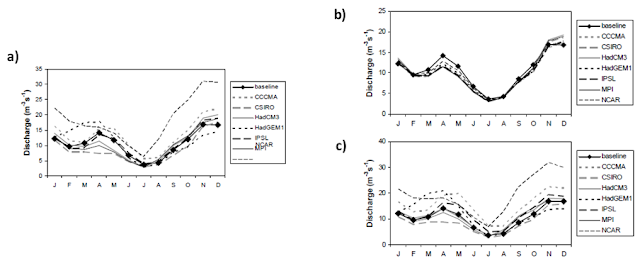Uncertainty in hydrological
model structure and calibration, and parameterisation uncertainty
Uncertainty in the hydrological
model can result during its calibration. For example, Kingston and Taylor (2010) experienced occasionally very poor month-to-month performance of the model, with
substantial monthly flow events either missing or erroneously introduced in the
modelled time series. They attributed this to discrepancies between the
observed (station-based) precipitation data within the Mitano Basin and the CRU
TS 3.0 data set used for calibration of hydrological model – in other words, the
gridded rainfall data over the Mitano Basin that the model was run with was of
dubious accuracy (Kingston and Taylor, 2010). This poor month-to-month
performance remained following autocalibration routines and manual calibration
of the most sensitive parameters, despite close matching of the flow duration
curves (Kingston and Taylor, 2010). Even in the context of possible errors in
the observed discharge data of +/- 15% (Mileham et al., 2008), the errors produced were large, showing that some uncertainty pertaining to
model calibration will always remain.
Uncertainty in the
parameters of the hydrological model (i.e. model parameterisation) is a
possible cause for additional uncertainty in climate change projections of
freshwater. However, Kingston and Taylor (2010) undertook an uncertainty
analysis through manually varying the 10 most sensitive parameters, including
evapotranspiration and soil water capacity, in their hydrological model for the
Mitano Basin. This indicated that the effects of hydrological model parameter
uncertainty on simulated runoff changes are small when compared to those associated with choice of GCM, climate scenario
and PET algorithm, in agreement with much literature (Cisneros et al., 2014; e.g. Arnell, 2011; Lawrence and Haddeland, 2011). However this was a limited and
subjective assessment only performed on the HadCM3 GCM, so greater parameter
uncertainty may be present for GCMs with more extreme climate scenarios.
Uncertainty in
downscaling
The estimated impacts of climate change on freshwater
resources can be very dependent on the approach used to downscale the climate
model data, as demonstrated through systematic evaluations of different methods
(Quintana Segui et al., 2010). In fact the range in projected change between downscaling approaches can be
as large as the range between different climate models (Chen et al., 2011). Downscaling methods may also encompass assumptions, for example, Kingston and Taylor (2010) downscaled monthly climate data to a daily scale suing the
ClimGen weather generator, which is based on the assumption that the pattern of
climate change is relatively constant for a given GCM (Arnell and Osborn, 2006) – yet it is questionable if this is always the case.
Uncertainty due to lack of data
As mentioned previously with PET estimation, the projections
of freshwater availability are limited by the quality of input data. In the
case of Kingston and Taylor (2010), neither temperature nor evaporations data
were available for the Mitano basin, so that the closest available observations
were from the town of Mbarara, approximately 50 km to the East of the
catchment. This would have introduced uncertainty into their models.
Furthermore, the Mitano hydrological model was calibrated for the 1961-90
baseline period using daily river discharge data from only a single gauging station within the
catchment – where data from more gauging stations would have been preferable
(Kingston and Taylor, 2010). Lastly, in validating the hydrological model, the
closest rainfall station to the Mitano River Basin in the CRU TS 3.0 data set
became unavailable from 1996 onwards, with the new nearest available rainfall
station located approximately 115 km from the basin – potentially being the
cause of poorer performance of the validation period for the hydrological model
compared to the calibration period (Kingston and Taylor, 2010).
Conclusions
This review includes the
evaluation of uncertainty due to choice of GCM, estimation of PET, hydrological
model structure and calibration, and limitations of the data used. The main
outcome is the major dependence on the GCM used, with estimation of PET being
another major source of uncertainty. Climate sensitivity is another source of
uncertainty (Kingston and Taylor, 2010) which has not been explored in this
post, although Cisneros et al. (2014) argue that the relative weightings given
to different emissions scenarios are typically less important in determining
the distribution of future impacts than the initial selection of GCMs considered.
For the near future at least, uncertainty in modelling future precipitation and
freshwater resources under climate change will always have some uncertainty, so
climate change scenario runs should always be evaluated within the context of
all this uncertainty.








